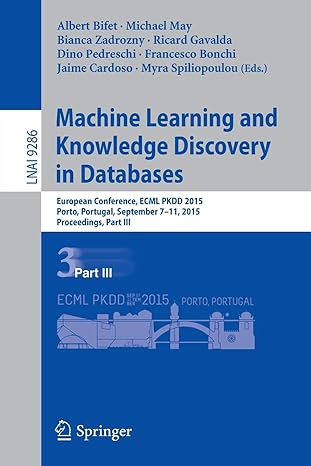Question
***In JAVA*** The sorting algorithms that will be examined are: Selection sort Insertion sort Merge sort Quick Sort All sorting algorithms must sort the arrays
***In JAVA***The sorting algorithms that will be examined are:
- Selection sort
- Insertion sort
- Merge sort
- Quick Sort
All sorting algorithms must sort the arrays in ascending order.
Each sorting and searching algorithm will be comparatively run on arrays of the following sizes:
- fifty (50)
- one thousand (1,000)
- ten thousand (10,000)
- one hundred thousand (100,000)
- one million (1,000,000)
Each sort is to be tested on the same data set to strive for some consistency.
Sorting Methodology and Requirements:
- Create a core data set called coreData which must be a single array of size one million (1,000,000) integers filled with random numbers between one (1) and three million (3,000,000).
- For each comparative test, four (4) copies (one for each sort to be tested) consisting of the same data from coreData must be made. For example, if the comparative test is on one thousand (1,000) elements, four arrays of size (1000) should be made and filled with a copy of the first one thousand (1000) elements of coreData.
All recorded times must be measured using System.nanoTime() for best accuracy. An example of how to use it is given below.
| long start = System.nanoTime(); //code to be tested long end = System.nanoTime(); long timeTaken = end start; |
The unit for printing the time must be done according to the following table:
| Test data size | Time unit |
| 50 | nanoseconds |
| 1,000 | nanoseconds |
| 10,000 | nanoseconds |
| 100,000 | nanoseconds |
| 1,000,000 | millisecond |
Output requirements:
The name of each sorting algorithm tested and the time it took to sort the data must be shown grouped by the test data size. For a test data size of fifty (50), the time taken for all the sorting algorithms to sort the data must be shown one after another.
Fill in the tables below with the results of your tests such as Selection sorts, Insertion sorts, Merge sorts and Quick sorts
| Number of Items | |||||
| Selection Sort | 50 | 1,000 | 10,000 | 100,000 | 1,000,000 |
| Run 1 | |||||
| Run 2 | |||||
| Run 3 | |||||
| Run 4 | |||||
| Run 5 | |||||
| Average | |||||
Step by Step Solution
There are 3 Steps involved in it
Step: 1

Get Instant Access to Expert-Tailored Solutions
See step-by-step solutions with expert insights and AI powered tools for academic success
Step: 2

Step: 3

Ace Your Homework with AI
Get the answers you need in no time with our AI-driven, step-by-step assistance
Get Started


